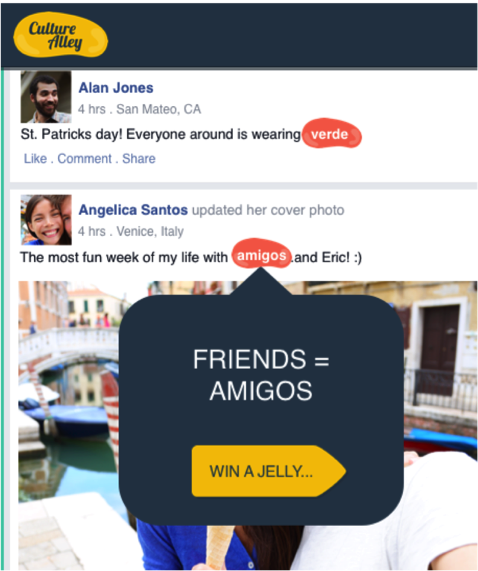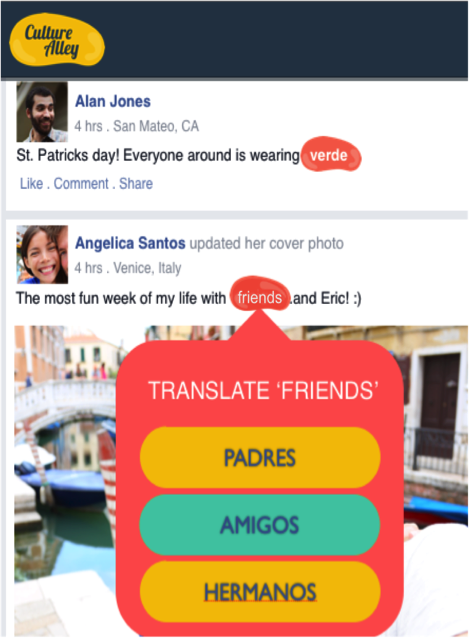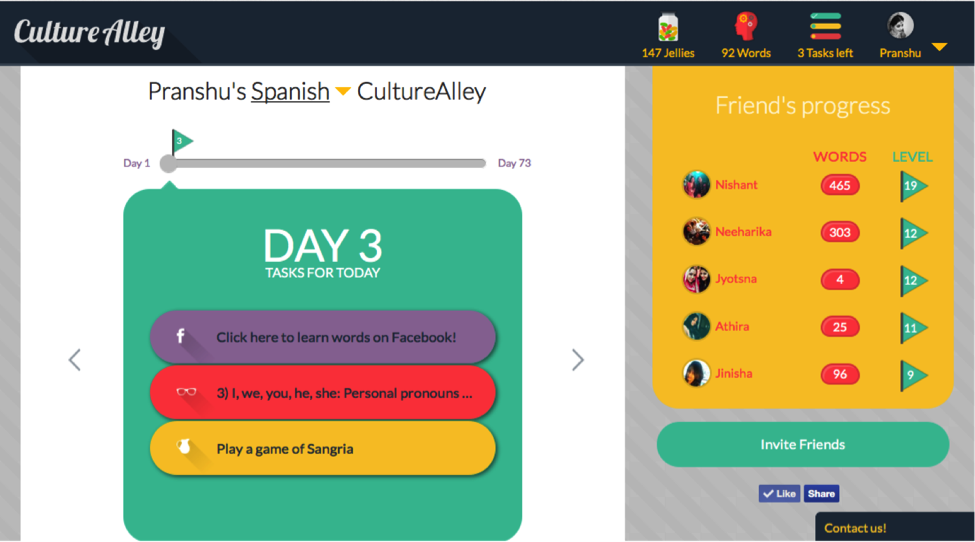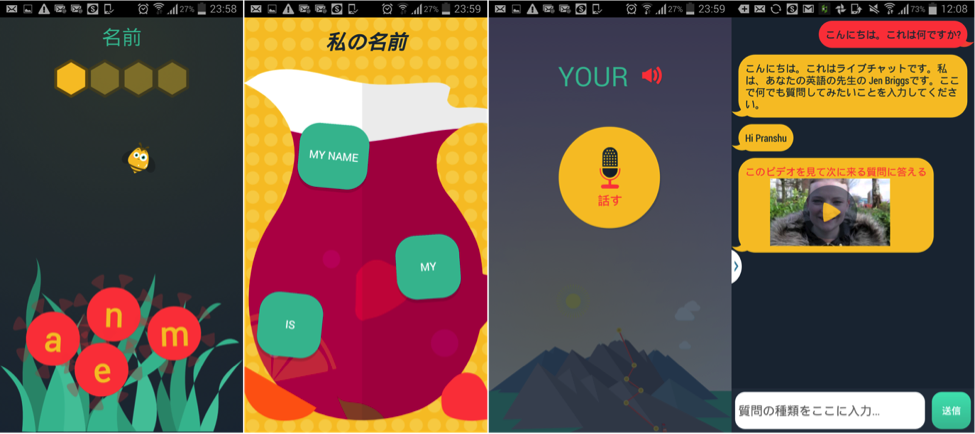CultureAlley combines the 2 most addictive online habits – Social Media and Gamification, to help people learn foreign languages. It attacks boring, generic, and old school pedagogy in education and turns it on its head. It turns the ridiculous number of hours spent on social media, and the web, into a language lesson. CultureAlley was founded by Nishant Patni and Pranshu Bhandari in 2012.
Introduction
When I joined Microsoft in Shanghai, the company helpfully offered me 60 hours of 1-1 tutoring so I could learn Mandarin. I was excited to be able to learn the language. My tutor was decent, her English was better than average, and she had good structured lessons she followed through. However, it didn’t prove very useful for me – even after spending 2 years in Shanghai, I couldn’t manage anything more than being able to give driving directions to the taxi driver, and of course the usual greetings.
One of the biggest challenges was that even though the words and phrases that I was being taught were commonplace and important, I didn’t have to use most of them at my workplace or during other interactions with Chinese people. So I kept forgetting those words, and since I didn’t have a way to learn the words my program managers and developers used at workplace, my language skills never went beyond the survival level. And finally, I gave up even trying.
This has been the experience of many language learners, language teaching is not personalized, and it doesn’t take your context and interest into consideration. This means high dropout rate and diminished utility of such teaching.
Nishant Patni, founder of CultureAlley, narrates a similar experience when he had to spend time in China, which prompted him to look for better ways of language learning. He started CultureAlley, along with his co-founder, Pranshu Bhandari, in 2012 to offer a better way of language learning.
CultureAlley makes language learning simple, by personalizing and contextualizing the learning.
The way it does it is by taking the learners’ social media feeds (Facebook, Twitter etc.) and replacing parts of it into the language that the user is trying to learn. E.g. If your friends are saying “Hi” on Facebook it gets replaced with “ni hao” and you get to listen, learn, and collect these new words by tapping on them. Everything is progressive to the learner’s level. Every new word you learn, you get rewarded (think Candy Crush) and you keep competing with your Facebook friends on how many words you learn! The same experience is extended across the web using their Chrome browser plugins.
Learning is supplemented with bite-sized interactive lessons and fun games.
So you may be learning Chinese while browsing Facebook, Wikipedia, and TechCrunch, following your regular lifestyle, and learning words that are relevant for you.


The Product
In addition to having regular features of any language learning (audio-visual language lessons, interactive practice games, dictionaries, Q&A forums, online tutoring), CultureAlley is the only major player to utilize web browsing, Social media and gamification techniques to teach languages. This way, they are much more immersive and personalized.
They have Facebook based web offerings for Spanish, Mandarin Chinese, Portuguese, and English for Latin American Speakers. And they have recently launched an Android App that teaches English to Japanese speakers. Another Android App to teach English to Indians (Hindi speakers) is slated to be out very soon. .

They make the learning process:
- Personalized to the learner’s interests – users learn the words and phrases that they are interested in talking about
- Highly contextual – You discover new words in a conversation – knowing exactly when to use them
- Absolutely real-time – Every time you go to the app you have fresh content to learn with!
- Gamified and fun – Everything you do you are rewarded for and you keep competing with your Facebook friends on your learning goals!

CultureAlley uses a combination of Social media APIs and an intersection of Machine Translation algorithms and human curated data-sets to personalize the learning experience of all the learners. These are used in the Facebook apps, the web-apps, the Browser Plugins and the mobile apps.
They use their own text-to-speech engine to provide speech recognition features to provide feedback on accents and user pronunciation on their mobile apps. There are several games that users play in a candy-crush sort of a journey including a cool Karaoke-like tool that allows learners to learn a language while watching movies, and YouTube videos. The mobile app also has a cool live chat functionality – which allows CultureAlley to push interesting content (including interactive video quizzes) to learners everyday and allows learners to in-turn ask questions to English tutors on a live chat.

Product Development
The product team consists of young engineers from NITs and IIT-B, focusing on technology stack and features.
Maintaining a high level of quality on the content that they create as they scale, is a key challenge for them. They rely on quality control processes in house and work with a bunch of language professionals who do both the content creation and testing – they have a community of ~500 vetted language professionals who teach at CultureAlley as well.
CultureAlley has a very interesting talent strategy for their software development which helps them execute well, even while based out of a tier-2 city like Jaipur:
- They are located next door to NIT Jaipur so they get good talent access
- Founder is a hands-on technologist, so technology leadership has not been a challenge for them
- Finding UX/Design talent is hard, but the founding team has a designer/artist in it
- Founders spend part of the year in San Francisco where they have created their eco-system to access local design talent, get quick prototyping, and user testing
Being distributed for part of the year doesn’t create problem for them, Skype and Google Docs are used for collaboration all the time, with DropBox for document sharing.
Market
The global market for digital English language learning products reached $1.8 billion in 2013, which is less than 3% of total English language learning market. Global learning (all languages) is around $115B. 1 in 5 in the world are learning English right now. So we are talking of some extremely large market sizes here.
CultureAlley has about 340K users, using its web, facebook, and mobile products, growing at a rapid pace of 25% month on month. They target 3 segments (#1 being their primary target):
- Working professionals learning new language (job prospects) – 60% of the market
- Students to get better grades
- Biz travelers, travel enthusiasts
Their web offering is free, while the mobile app is freemium where the users have to pay to unlock advanced levels (pricing varies based on different language pairs) . They also offer Skype based tuitions and doubt-clearing sessions through a large selection of online tutors.
There are some worthy competitors in this arena – DuoLingo (good mobile interface and gamified learning approach), Rosetta Stone (focused on the US market, old school approach to language learning), OpenEnglish (Latin America based English teaching player, focused on Video Conferencing based group lessons). However, CultureAlley feels its contextual and social media based approach to language learning is highly complementary to most of the content focused players in the industry, providing ample partnership opportunities.
Roadmap
They are focused on the following for the next 12-18 months:
- 10 different language pairs (language you want to learn, and the language that you know)
- 4 different channels – Facebook, Browser-plugin, devices (iOS, android, wearable), Twitter based product
- 1.5M users
- Continued focus on design and usability of product
Their vision is to provide highly contextual learning, using video content (YouTube) as learning tool (similar to what they do to Facebook feeds), and create compelling content for wearable apps.
The Road Ahead
The language learning space is huge, and is ripe for disruption because of the old school teaching methodology of current products, and CultureAlley has a compelling solution. This seems to be a great opportunity for them to grow very big very fast and capture a large market segment. However, they need to be careful about the moves large publishers (entrenched, largely offline players in English language learning space like Pearson) are making to co-opt the space – busuu (an online language learning company with 40M users) recently tied up with Pearson English to offer a standardized English assessment to its users, for example. This is also a space buzzing with startup activities and ample funding ($3.3M average valuation of 232 language learning startups according to AngelList).
CultureAlley products are compelling to use and their roadmap is rich and headed in the right direction. As they scale to more languages pairs, channels, and engagement techniques, future is very bright for them.

